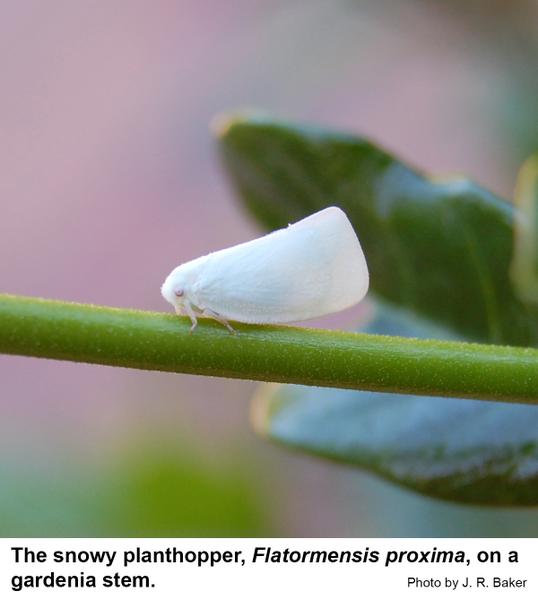Description and Biology
The snowy planthopper, Flatormenis proxima, overwinters as eggs laid through the bark so that the group vaguely resemble a zipper. Eggs start hatching in spring, and nymphs are found from April (coastal plain) through June (higher elevations). Development from egg to adult takes about 178 days. Adults live for several weeks and are found from late June through late September. Only one generation occurs each year. Eggs laid in the bark of the current year's growth of a woody host plant, usually a tree such as black walnut. The nymphs often descend to understory plants to feed and develop. Snowy planthoppers are usually noticed because of the white, fluffy secretions of the nymphs, which can completely obscure the insect. This fluffy material is left behind on leaves and stems when the adult emerges or when the nymph is disturbed and jumps away. The adults are also snowy white. The fluffy secretion of nymphs resembles that of mealybugs, woolly aphids, and certain soft scale insect egg masses. However, if the snowy planthopper nymph is disturbed, it often jumps for several inches whereas mealybugs, aphids, and soft scales are sedentary and crawl slowly if at all when disturbed.
Host Plants
Snowy planthoppers do little real damage to the health of crape myrtle, gardenia, azalea, and other woody ornamentals. The fluffy secretions of the nymphs sometimes cause alarm to amateur horticulturists because they resemble secretions of mealybugs, woolly aphids, and certain soft scale insect egg masses. These planthoppers do excrete honeydew as they feed. Sooty molds sometimes grow in honeydew so that if snowy planthoppers were to become extremely abundant, they might indirectly cause the host plant to become darkened with sooty molds.
Residential Recommendation
High rates of nitrogen fertilizer favor the development of planthoppers. Although other species of planthoppers can spread plant viruses, this has not been documented for snowy planthoppers. Snowy planthoppers are plagued by tiny wasps in the family Dryinidae. Spiders also prey upon these insects. Unless snowy planthoppers are extremely abundant, no control measures should be used as most insecticides also impact beneficial insects. If the snowy planthoppers are causing noticeable damage, they should be susceptible to most contact insecticides available in plant centers and the gardening section of big box stores. Resistance to pesticides has not been shown with snowy planthoppers.
References
- Planthoppers: their ecology and management. Denno, R. F. and T. J. Perfect. 1994. Chapman & Hall, New York. X + 799 pp.
- Life histories of Anormenis septentrionalis, Metcalfa pruninosa, and Ormenoides venusta with descriptions of immature stages. Wilson, S. W. and J. E. McPherson. 1981. Ann. Entomol. Soc. Amer. 74 (3): 299-311. {Note: Anormenis septentrionalis is an older name for Flatormensis proxima.}
- Extension Plant Pathology Publications and Factsheets
- Horticultural Science Publications
- North Carolina Agricultural Chemicals Manual
For assistance with a specific problem, contact your local Cooperative Extension Center.
This Factsheet has not been peer reviewed.
Publication date: Aug. 4, 2014
Reviewed/Revised: Aug. 20, 2020
Recommendations for the use of agricultural chemicals are included in this publication as a convenience to the reader. The use of brand names and any mention or listing of commercial products or services in this publication does not imply endorsement by NC State University or N.C. A&T State University nor discrimination against similar products or services not mentioned. Individuals who use agricultural chemicals are responsible for ensuring that the intended use complies with current regulations and conforms to the product label. Be sure to obtain current information about usage regulations and examine a current product label before applying any chemical. For assistance, contact your local N.C. Cooperative Extension county center.
N.C. Cooperative Extension prohibits discrimination and harassment regardless of age, color, disability, family and marital status, gender identity, national origin, political beliefs, race, religion, sex (including pregnancy), sexual orientation and veteran status.


